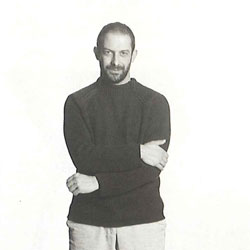Francisco Tropa
Francisco TropaLisboa ¶ 1968
 |
|
| Créditos fotográficos / Photographic credits: Abílio Leitão |
He was an undergraduate student at António Arroio, in Lisbon, and finished his studies at Ar.Co, where he has been a teacher in the Sculpture Department since 1996, and from whom he received a scholarship to study at London's Royal College of Arts in 1992. Tropa was also the recipient of a 1995-1996 scholarship of the Alfred Topfel Foundation, of the Münster Kunstakademie. He has won several prizes, including the Amstelveen Award (1997) and the Drawing Award at the Caldas da Rainha biennial (1998). ¶ Although Tropa has been exhibiting since the late 80s, it was the subsequent decade that witnessed the growing recognition of his work, whether from the repeated participations in several collective exhibitions, whose high moment was the project he co-created with Lourdes Castro for the 24th Biennial of São Paulo (1999), or from his participation in the 2003 Venice biennial with his Une table qui aiguisera votre appetit - Le poids poli (A table that'll whet your appetite. The polished weight). ¶ His work is usually focused on the modes of seeing and perceiving spaces, works into which the spectator is drawn in order to reconstruct or bring the work to a permanent conclusion. Therefore, each work must be considered as moment widened in time though restrained where it concerns the time given to the observation and the assimilation of its concepts. His works are, before all, "situations in process" which achieve their own sense through perception and experience. At a crossroads of performance and installation, Francisco Tropa creates ambiences that have a clear concern in understanding scientifically the volume that is occupied by the various objects, and by the behaviour they have within a given space (Aproximando pessoas creativas, Approaching creative people, 2002, Porta 33 gallery, in Funchal). The artist bestows upon his projects an elegance that is quite close to the Minimalist reductions, although one may find subtle references to the geometrising abstraction of the historical Avant-gardes. Density, gravity, mass, volume, space. Such are the keywords of Tropa's artistic lexicon, more often than not associated to motion-generating mechanisms. Nonetheless, the materials are quite diverse: as sound (Os Potes e Farol, The Vases and the Lightning House, 2002), words, water waves and dust, (Observatório de Pó, Dust Observatory, 1996). The methods are equally variable and in accordance to the accidents of the given work. If his works fulfil their significance at both a sensorial and cognitive level, it is through observation (Observatório de Insectos, Insect Observatory, 1996, and Projecto Casalinho, Casalinho Project, 1997); the spectator interacts and becomes one with the objects, in a process of self-knowledge.
http://cvc.instituto-camoes.pt/biografias-en/francisco-tropa-47198-dp2.html#sigFreeId67af684be0


